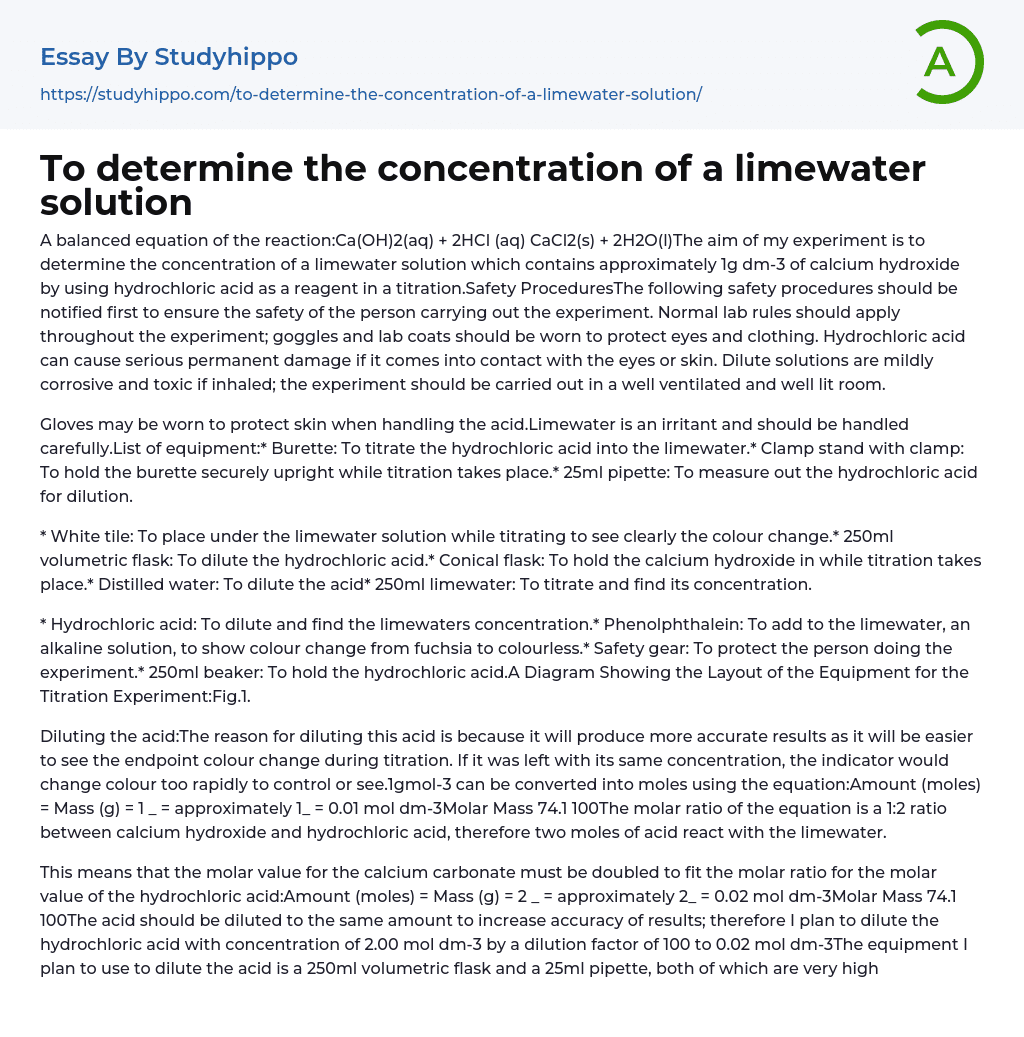

To determine the concentration of a limewater solution Essay Example
A balanced equation of the reaction:Ca(OH)2(aq) + 2HCl (aq) CaCl2(s) + 2H2O(l)The aim of my experiment is to determine the concentration of a limewater solution which contains approximately 1g dm-3 of calcium hydroxide by using hydrochloric acid as a reagent in a titration.Safety ProceduresThe following safety procedures should be notified first to ensure the safety of the person carrying out the experiment. Normal lab rules should apply throughout the experiment; goggles and lab coats should be worn to protect eyes and clothing. Hydrochloric acid can cause serious permanent damage if it comes into contact with the eyes or skin. Dilute solutions are mildly corrosive and toxic if inhaled; the experiment should be carried out in a well ventilated and well lit room.
Gloves may be worn to protect skin when handling the acid.Limewater is an irritant and should be handled carefully.List of
...equipment:* Burette: To titrate the hydrochloric acid into the limewater.* Clamp stand with clamp: To hold the burette securely upright while titration takes place.* 25ml pipette: To measure out the hydrochloric acid for dilution.
* White tile: To place under the limewater solution while titrating to see clearly the colour change.* 250ml volumetric flask: To dilute the hydrochloric acid.* Conical flask: To hold the calcium hydroxide in while titration takes place.* Distilled water: To dilute the acid* 250ml limewater: To titrate and find its concentration.
* Hydrochloric acid: To dilute and find the limewaters concentration.* Phenolphthalein: To add to the limewater, an alkaline solution, to show colour change from fuchsia to colourless.* Safety gear: To protect the person doing the experiment.* 250ml beaker: To hold the hydrochloric acid.A Diagram Showing the Layout of the Equipmen
for the Titration Experiment:Fig.1.
Diluting the acid:The reason for diluting this acid is because it will produce more accurate results as it will be easier to see the endpoint colour change during titration. If it was left with its same concentration, the indicator would change colour too rapidly to control or see.1gmol-3 can be converted into moles using the equation:Amount (moles) = Mass (g) = 1 _ = approximately 1_ = 0.01 mol dm-3Molar Mass 74.1 100The molar ratio of the equation is a 1:2 ratio between calcium hydroxide and hydrochloric acid, therefore two moles of acid react with the limewater.
This means that the molar value for the calcium carbonate must be doubled to fit the molar ratio for the molar value of the hydrochloric acid:Amount (moles) = Mass (g) = 2 _ = approximately 2_ = 0.02 mol dm-3Molar Mass 74.1 100The acid should be diluted to the same amount to increase accuracy of results; therefore I plan to dilute the hydrochloric acid with concentration of 2.00 mol dm-3 by a dilution factor of 100 to 0.02 mol dm-3The equipment I plan to use to dilute the acid is a 250ml volumetric flask and a 25ml pipette, both of which are very high in accuracy which will benefit my results in finding the exact concentration of the limewater solution.
To dilute the acid I plan to first measure out 25ml of the 2.00 mol dm-3 hydrochloric acid using a 25ml pipette, making sure that the bottom of the meniscus is on the line (see fig.2.). Then place this measured amount into the 250ml volumetric flask and add distilled water up until the 250ml line.
This
process will dilute the acid to 0.2 mol dm-3 therefore by repeating the process again the molar will be diluted a further 10% and will be 0.02 mol dm-3 which is a sensible concentration to use for titration. Read about 6 Strong AcidsMethod:The experiments should be performed at room temperature and pressure as this will increase accuracy in the results produced.
Once the acid has been fully diluted to 0.02 mol dm-3 the calcium chloride can be titrated.Measure out 25ml of calcium hydroxide into a conical flask using a 25ml pipette by squeezing the pipette pump until the solution is past the 25ml line and then removing the pump to lower the meniscus exactly onto the line, (see Fig.2.).
Add a few drops of phenolphthalein; the colour of the solution should turn pink or fuchsia coloured which will indicate a solution of high pH value. The indicator will turn colourless below pH 8 when the limewater has become fully neutralised by the hydrochloric acid.To begin the titration, set up the equipment as shown in fig.1. Fill the burette with the diluted hydrochloric acid using a funnel which must be removed at the start of the titration as it will decrease accuracy of results by increasing the volume of the acid in the burette.
Place the conical flask of calcium hydroxide under the burette and on top of the white tile so that the colour change of the phenolphthalein is more evident to see.
- Acid Rain essays
- Acid essays
- Calcium essays
- Carbohydrate essays
- Carbon essays
- Chemical Bond essays
- Chemical Reaction essays
- Chemical reactions essays
- Chromatography essays
- Concentration essays
- Copper essays
- Diffusion essays
- Ethanol essays
- Hydrogen essays
- Organic Chemistry essays
- Osmosis essays
- Periodic Table essays
- Ph essays
- Salt essays
- Sodium essays
- Titration essays



